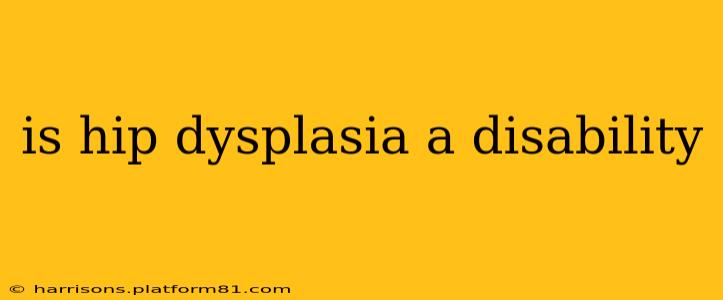Hip dysplasia, a condition affecting the hip joint's development, can significantly impact a person's life. Whether or not it qualifies as a "disability" depends on several factors, making it a nuanced question with no simple yes or no answer. This article delves into the complexities, exploring the criteria used to define disability and how hip dysplasia fits into that framework.
What is Hip Dysplasia?
Hip dysplasia refers to an abnormal development of the hip socket, causing the ball and socket joint to not fit together properly. This misalignment can lead to a range of symptoms, from mild discomfort to severe pain and limited mobility. The severity varies greatly, depending on factors like the degree of misalignment and the individual's age at diagnosis. In infants, it's often detected through screening, while in adults, symptoms may only appear later in life.
How is Disability Defined?
The definition of "disability" varies depending on the context. Legally, disability is often defined by whether a condition substantially limits one or more major life activities. This includes things like walking, standing, lifting, and bending. Many countries have specific criteria, often relying on medical evaluations and functional assessments. The social model of disability emphasizes societal barriers as a key factor, arguing that limitations are often created by societal structures rather than solely by the medical condition itself.
Can Hip Dysplasia Substantially Limit Major Life Activities?
The answer to this depends entirely on the severity of the individual's hip dysplasia. Mild cases may cause minimal discomfort and not interfere with daily life. However, severe cases can significantly restrict mobility, causing pain during walking, sitting, and even sleeping. This can limit participation in work, social activities, and even basic self-care.
What are the specific limitations caused by hip dysplasia?
Severe hip dysplasia can lead to a variety of limitations impacting major life activities, including:
- Mobility: Difficulty walking, climbing stairs, or even standing for extended periods.
- Pain Management: Constant or intermittent pain requiring medication and potentially impacting work and social life.
- Employment: Inability to perform job duties requiring physical exertion or prolonged standing/sitting.
- Social Participation: Reduced ability to engage in social activities due to pain or limited mobility.
- Self-Care: Difficulty with tasks like dressing, bathing, and using the restroom.
These limitations, when significant enough, meet the criteria for disability under many legal definitions.
Does the need for assistive devices indicate disability?
The need for assistive devices like canes, walkers, or wheelchairs is often a strong indicator of significant limitations. These devices are used to compensate for impaired mobility and functional capacity, further supporting the case for disability classification.
What about the social model of disability?
Even with mild hip dysplasia, societal barriers can impact a person's experience. Lack of accessible transportation, buildings, and workplaces can create significant limitations for individuals with mobility challenges, regardless of the severity of their condition. This highlights the importance of considering both the medical and social aspects of disability.
Can hip dysplasia be considered a disability for social security benefits or other programs?
The eligibility for social security disability or other government assistance programs depends on meeting specific criteria outlined by those programs. This often involves medical documentation demonstrating the severity of the condition and its impact on the individual's ability to work. A thorough evaluation by a medical professional is crucial in determining eligibility.
In Conclusion
Whether hip dysplasia is considered a disability is not a simple yes or no answer. It depends on the individual's specific symptoms, the severity of their condition, and the context in which the question is being asked (e.g., legal definition, social model). The impact of hip dysplasia can range from minimal to significantly debilitating, impacting various aspects of daily life and potentially fulfilling the criteria for legal disability. Always consult with medical professionals and relevant authorities for accurate assessments and guidance.
